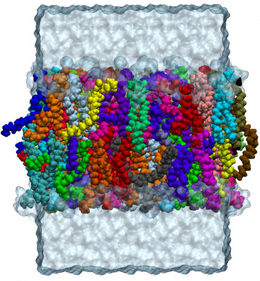Research Abstract
細胞膜表面の水分子の異常拡散の起源
Origin of subdiffusion of water molecules on cell membrane surfaces
2014年4月17日 Scientific Reports 4 : 4720 doi: 10.1038/srep04720

水分子は細胞膜上での生物学的反応を円滑に行わせる環境を提供する役割を担っている。水分子は、脂質分子と結合し、細胞膜を安定化させると広く考えられている。我々は、全原子の分子動力学シミュレーションを行い、脂質膜表面の水分子の並進拡散や回転拡散が、異常拡散およびエイジング(拡散性が時間とともに低下する現象)を示すことを明らかにする。その上、平均トラップ時間の発散(連続時間ランダムウォーク)と長時間の相関を持つノイズ(非整数ブラウン運動)の両方が、この異常拡散に寄与することを示す。これらの結果は、細胞膜上での水分子の流動性の低下による細胞膜安定性の増強、および反応効率の上昇が、異常拡散によってもたらされることを示唆している。
山本 詠士1, 秋元 琢磨1, 安井 正人2 & 泰岡 顕治1
- 慶應義塾大学 理工学部 機械工学科
- 慶應義塾大学 医学部 薬理学教室
Water molecules play an important role in providing unique environments for biological reactions on cell membranes. It is widely believed that water molecules form bridges that connect lipid molecules and stabilize cell membranes. Using all-atom molecular dynamics simulations, we show that translational and rotational diffusion of water molecules on lipid membrane surfaces exhibit subdiffusion and aging. Moreover, we provide evidence that both divergent mean trapping time (continuous-time random walk) and long-correlated noise (fractional Brownian motion) contribute to this subdiffusion. These results suggest that subdiffusion on cell membranes causes the water retardation, an enhancement of cell membrane stability, and a higher reaction efficiency.

